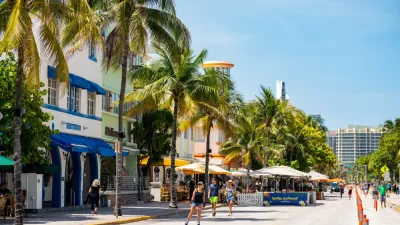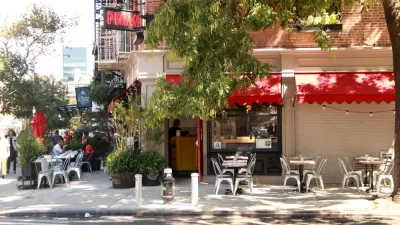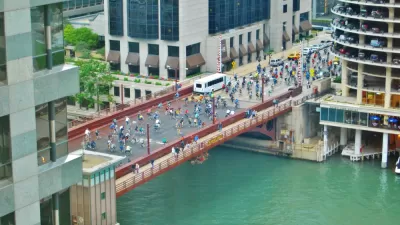The successes and failures of past pedestrian malls can inform the future of pandemic-induced "open streets" programs.

The COVID-19 pandemic, writes Stephan Schmidt, emphasized the importance of public, outdoor space as cities around the world opened previously car-centric streets to pedestrians and reimagined street space as more than a way to move cars from place to place. "Alternatively referred to as slow, open, shared or active streets, many of these pandemic-inspired closures were successful, and several cities opted to continue these street changes over the course of the summer."
Now, "as summer ends and cities continue to reopen, local officials will need to decide whether to revert to the status quo or make the often-popular pedestrianized corridors permanent."
Describing the history of American pedestrian malls and their rise and fall during the 1960s through 1990s, Stephan Schmidt draws comparisons to today's pandemic streets, taking lessons from the successes and failures of the past to inform our current car-free projects. Cities, Schmidt writes, can "utilize design interventions to create more desirable pedestrian environments" and support car-free areas.
Based on his research, Schmidt describes four elements of successful pedestrian malls. These include "creating a sense of enclosure and requiring the use of ground-floor windows to increase transparency," protection from weather and varied seating options, visual appeal created through landscaping, and programmed activities. He also recommends that pedestrian malls seek connections with adjacent properties to reduce a feeling of isolation and increase pedestrian traffic.
"Many downtowns and central business districts now have more full-time residents than they did in decades past, a density boost that bodes well for this new wave of shared streets. Officials must weigh many factors as they bring their urban centers back to 'normal,' but they should remember that, for many, normal means experiencing the city via a car-free public space."
FULL STORY: Lessons From the Rise and Fall of the Pedestrian Mall

Study: Maui’s Plan to Convert Vacation Rentals to Long-Term Housing Could Cause Nearly $1 Billion Economic Loss
The plan would reduce visitor accommodation by 25,% resulting in 1,900 jobs lost.

North Texas Transit Leaders Tout Benefits of TOD for Growing Region
At a summit focused on transit-oriented development, policymakers discussed how North Texas’ expanded light rail system can serve as a tool for economic growth.

Using Old Oil and Gas Wells for Green Energy Storage
Penn State researchers have found that repurposing abandoned oil and gas wells for geothermal-assisted compressed-air energy storage can boost efficiency, reduce environmental risks, and support clean energy and job transitions.

San Mateo Formally Opposes Freeway Project
The city council will send a letter to Caltrans urging the agency to reconsider a plan to expand the 101 through the city of San Mateo.

A Bronx Community Fights to Have its Voice Heard
After organizing and giving input for decades, the community around the Kingsbridge Armory might actually see it redeveloped — and they want to continue to have a say in how it goes.

Houston Mayor Promises Dedicated Austin Street Bike Lane After Public Backlash
Although the one-way bike lane won’t be protected by physical barriers, the proposal is an improvement over the mayor’s initial plan to only include sharrows on the Austin Street project.
Urban Design for Planners 1: Software Tools
This six-course series explores essential urban design concepts using open source software and equips planners with the tools they need to participate fully in the urban design process.
Planning for Universal Design
Learn the tools for implementing Universal Design in planning regulations.
Borough of Carlisle
Caltrans
Heyer Gruel & Associates PA
Institute for Housing and Urban Development Studies (IHS)
City of Grandview
Harvard GSD Executive Education
Toledo-Lucas County Plan Commissions
Salt Lake City
NYU Wagner Graduate School of Public Service





























